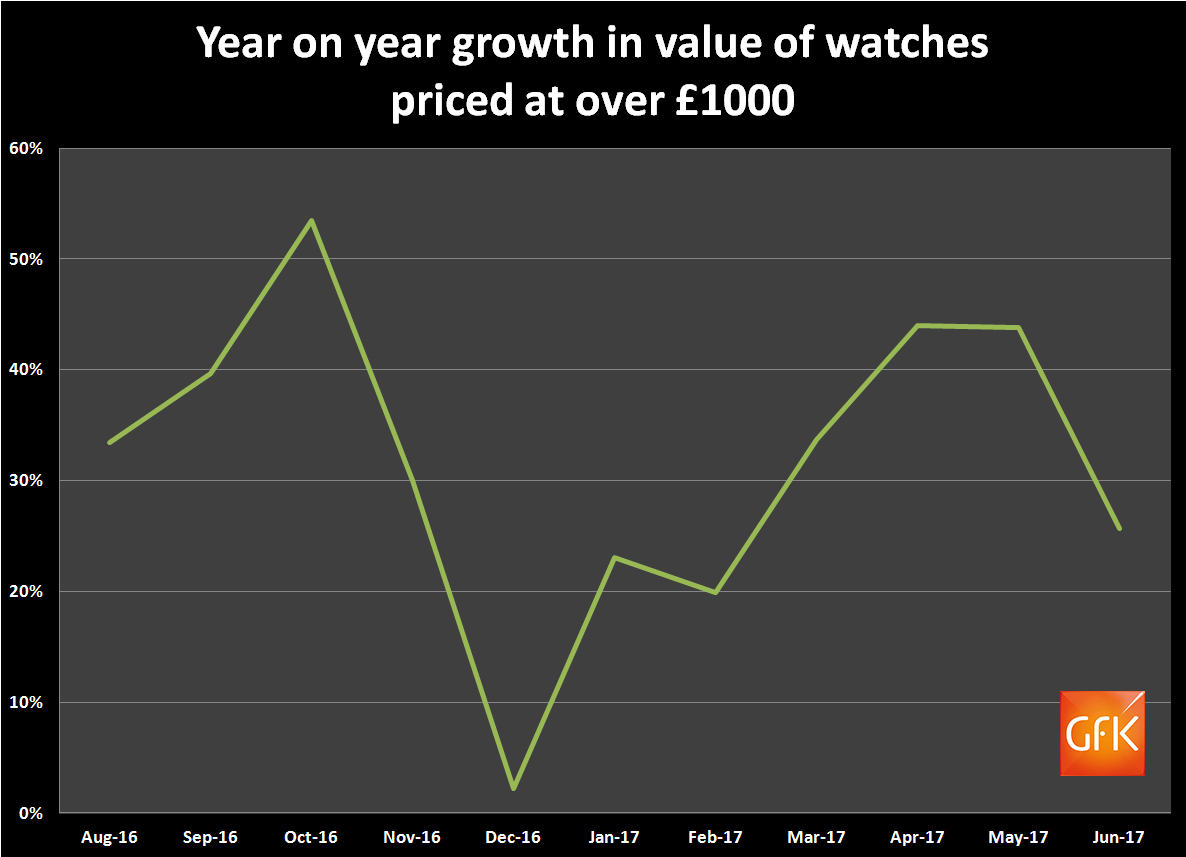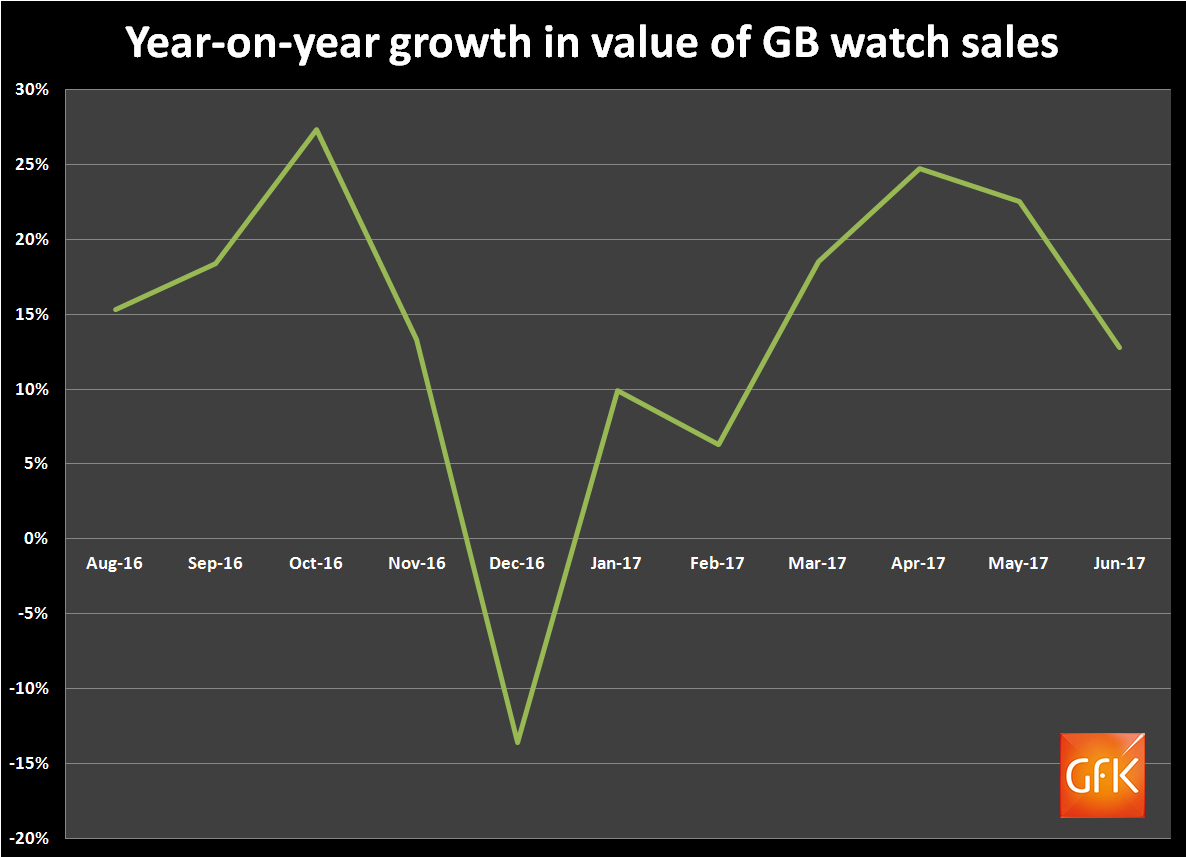They say a week is a long time in politics, which might explain why the EU Referendum in June 2016 feels like a lifetime ago. But only a year has passed, and finally we will start to compare year-on-year monthly sales figures to post-Brexit months when the pound had fallen in value by over 20%. We are not quite there yet, because the beginning of June 2016 was a hiatus as the country stopped for the referendum then rapidly went back to business at the end of the month, as GfK account director Paul Mitchell describes.
A year on from the Brexit referendum, the watch market in Great Britain is still recording double digit percentage growth rates. Value sales in June 2017 were up 12.8% versus the same period 12 months ago, with the rate of growth for the first half of the year standing at 15.7% against Jan-Jun 2016.
It will be no surprise to learn that growth continues to be driven by the high end of the market and that the sub-£500 sector remains challenging.
Within this, there is a clear difference in the performance between Gents and Ladies watches, with the former growing value sales by 16.0% in June 2017 versus June 2016, with the latter up by 5.0% in the same period.
The average selling price across the whole market increased by 23.6% when comparing June 2017 with June 2016.

Whilst the watch market performed well over the past year and there is little sign of value sales slowing down any time soon, future success is not guaranteed. It may seem that retailers and brands in the mid to high end of the market will continue to do well for the foreseeable future, but there are a number of short and long term factors which need to be considered if success is to be sustained.
In the short term, there is a still a lack of confidence among consumers. In June, Consumer Confidence fell by -5 points to -10 following the General Election result, the lowest level seen since the Brexit vote. That in itself may not dent luxury watch sales, but consumers continue to be worried about what the coming year will bring. Strong consumer spending has propped up the economy since June 2016 but now the twin pressures of higher prices and sluggish wage growth are squeezing household finances and adding to widespread fears of a Brexit-induced economic slowdown.
Added to this are continuing changes in shopper behavior and expectations. It’s more important than ever to understand consumers and deliver a compelling experience for them across all touch points on the path to purchase. It’s essential that retailers and brands have a single strategy for a digital world. Customers need a compelling reason to remain loyal. That’s easier said than done, but if it’s difficult to understand consumers today, wait until you try to understand consumers in the future.
Today, the true power rests in the palm of shoppers’ hands. The “always-on” culture of connectivity puts both manufacturers and retailers under intense pressure to stay relevant. This is a cut-throat, slim profit environment that is further endangered by emerging hyper-competition from global marketplaces, though this threat has been somewhat negated over the past year due to the low value of the pound attracting international customers. Be that as it may, conversion is more important than ever.

Within this environment, no retailer or manufacturer has a free pass to success; there is no guarantee that the strong performance of the UK watch market will continue. Clearly, whatever the sector, whatever the scale or geography, all players must constantly re-evaluate their strategies and tactics to ensure they win the connected shopper’s business.
Connected shoppers and their demands are the reason why retail is changing so quickly.
In the future, the shopper will be front and centre, and will have more control than ever before of how they shop and what they buy. For a 360° perspective, you need to evaluate key target audience segments in detail. How do they behave? What do they need? How can you meet their expectations? From Gen X, Y and Z to iBrains, Millennials and Baby Boomers, you need to reach your audience with a relevant product, service and experience at the right point in their purchase journey.
Considering the longer term, you particularly need to understand Generation Z (the iBrains). These digital natives will be tomorrow’s influencers, and they’ll herald a new era of retail with mobile at its heart. By 2020 a sizeable proportion of all consumers will be Gen Z-ers, so now is the time to get to know them.
For manufacturers, it’s also vital to encourage consumers to browse your products; to do this you not only need a strong brand, but good brand relationships too. Combining these two factors ensures you are top-of-mind in the brand consideration set, but achieving this is no easy feat. Consumers will only browse your brand if they have a neutral or good relationship with it, as past negative experiences represent an obstacle to future positive ones.
With more consumers than ever saying they feel overwhelmed by choice, understanding and helping shoppers find the products they really want will become a core tenet of a successful retailer and a successful brand. As a result, many marketing budgets are shifting to content and attribution marketing to be closer to the shopper during the moments that matter. The focus will be less on where the purchase happens, and much more on how you can influence it.
For the watch industry to best position itself for success in future, there are four key challenges concerning connected shoppers:
• Identify and anticipate future consumer needs
• Convert consumers into browsers
• Turn browsers into buyers
• Fine-tune and optimise pricing, assortment and promotional activity.
While sales continue to be strong for the GB watch market, success is not guaranteed. Retailers and manufacturers need to understand future consumers and how they will behave in a fully connected and fluid retail world if they are to drive future sales and meet consumer needs.
With thanks to the author :
Paul Mitchell, Account Director – Watches, GfK
paul.mitchell@gfk.com
+44 207 890 9045

